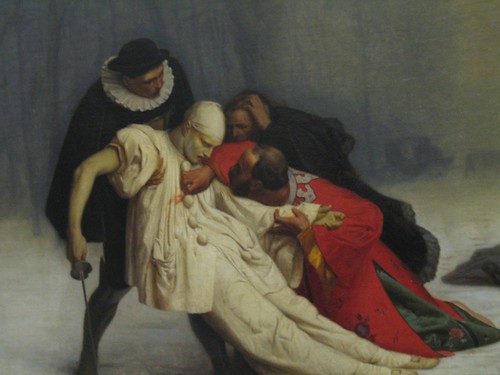I know it's the aftermath of a foolish duel, the painting itself tells me that, as well as the title, but - who, what, where and why? I've been trying to find out more information about the scene but to no avail - yet.
Jean Leon Gerome (1824 - 1904) was a successful painter and sculpture in the French Academic style. He is known and easily recognized for his Historical scenes, Orientalist themes as well as his work based on Greek Mythology. My other favorite of his paintings is the almost overwhelmingly romantic, Pygmalion and Galatea.
But lately I keep going back to Duel After the Masked Ball and wondering what on earth brought this on. Is the painting based on an actual duel? Or is it an allegory of some sort. The costumes are fairly specifically outlined in the descriptions I've found online - perhaps the meaning is in that specificity.
Though I am moved by the powerful scene, I am also caught up in its colorful, romantic melodrama.
There must have been some tremendous emnity involved, some dreadful breach of propriety - an insult that could not be borne. A personal affront? Impropriety with someone's wife or sister or whatnot? A blackening of the family name? A wager gone bad?
What do you think?
Detail



After doing a little Google "research" I discovered that the Duc de Guise, who is holding Pierrot and is referenced in that link you gave from The Walters Art Museum, is the son of the Duc d'Aumale. The paragraph mentions that the picture is an altered composition originally meant for the Duc d'Aumale. Must have some personal meaning for those two men long since gone.
ReplyDeleteI love it. It's one of those paitings that I think I could stare at for hours. I'm off to go see if there is a print of this available anywhere.
ReplyDeleteWouldn't it be interesting if the painting were a political commentary, just as so many nursery rhymes are?
ReplyDeleteI can think of any number of current politicos who should die sudden deaths, dressed as clowns!
I read that too, John, but still I wondered at the melodramatic tone and the costumes - the atmosphere.
ReplyDeleteMark may be right, there might have been some political attempt. Since the character in red is a 'Doge'.
One of the men walking away is an Indian, according to the limited information available.
Ryan, I don't think you'll have any problem finding a print. Jean Leon Gerome is a pretty popular artist - still.
ReplyDeleteMark, I wonder if maybe you aren't right. Though the clown on canvas is very tragically portrayed.
ReplyDeleteAnything is possible, I suppose, since I think all the costumes are supposed to be fairly specific.
I'm guessing someone "insulted" someone else's wife at that ball. Everyone was masked, so perhaps it was a case of mistaken identity. Anyway, the victim is costumed as one of the Italian Commedia dell'arte characters. Not sure about the others.
ReplyDeleteOne of Dorothy Sayers's mysteries (MURDER MUST ADVERTISE?) features a costume ball where Peter and others are dressed in a like style (Peter, I believe, is Harlequin). Agatha Christie also had a Commedia dell'arte ball in one of her short stories; two characters chose the same costume--you can guess the consequences.
Yvette, this painting lodged itself into my brain the minute I saw it here! Talk about a picture being worth a thousand words -- there's enough symbolism here to keep philosophical types pondering for ages! But I find the palpable emotions in the painting just as compelling as the figures depicted. It can be read in so many ways, though what comes to my mind most strongly is either some kind of symbolism (probably political), or as others have suggested, an argument (possibly a drunken one) at a gala costume ball that somehow went tragically wrong. Wow, you've really shaken up my thought processes here, Yvette! Thanks for giving me plenty of food for thought, my friend!
ReplyDeleteDeb, I saw the PBS version of the Christie story some time back, but was not very impressed with the adaptation. But, yes you're right, this sort of costume thing has been done in books.
ReplyDeleteI vaguely remember Wimsey dressed in masquerade. It suited him. :)
Dorian, I'm always happy to shake up people's thought processes. :)
ReplyDeleteThat's what I hoped to do with this post. It's SUCH an enigmatic and in so many ways, mysterious, painting.
I might, if I think about it, even see some sort of religous symbolism. We could talk about it for hours, I'll bet.
I'm wondering the exact same questions - I arrived here after just viewing this painting on the site http://gurneyjourney.blogspot.com/search/label/Composition?updated-max=2008-05-20T05:25:00-04:00&max-results=20&start=52&by-date=false. It is fascinating how a painting can immediately make you want to know more...and frustrating sometimes how hard it is to find out extra information!
ReplyDeleteThanks for stopping by, Blakeney. This is definitely one of the more mysterious paintings although John does give some info. (His is the first comment.)
ReplyDeleteBlakeney. As in Sir Percy?
Pierrot always represents unrequited love; the Indian represents brutality; the Harlequin, talking into the ear of the Indian, is an eternal trickster figure.
ReplyDelete